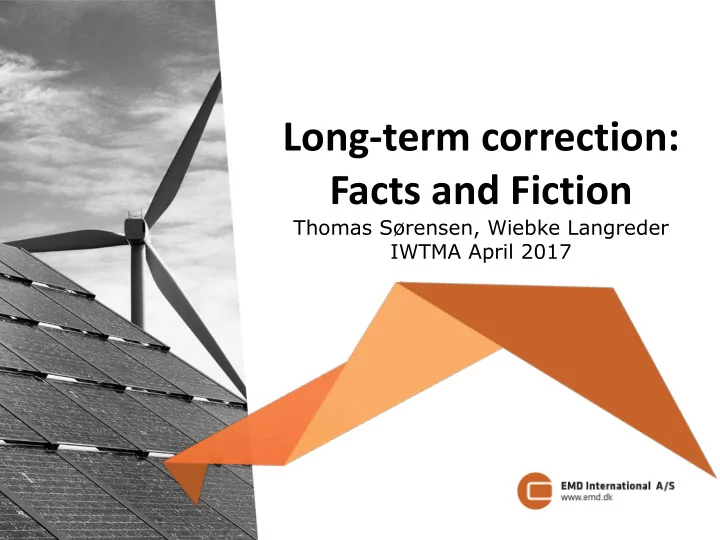

Long-term correction: Facts and Fiction Thomas Sørensen, Wiebke Langreder IWTMA April 2017
LT Long-term Correction Challenges: Nature: +/- 20% energy variation possible Man-made: CREYAP 1 (blind test) indicated LT correction as biggest source of deviation between consultants
Why? A number of choices have to be made: 1. LT data source 2. MCP (measure-correlate-predict) method – Artificial time series: Linear Regression or Matrix Method – Scaling: Wind Index (or better said Energy Index) But there is no guideline how to make a choice!
Common Consideration Key parameter: Wind Speed Correlation Coefficient R How well does the ST (short-term) data set correlate with LT data? But: Improved quality of meso-scale data (temporal and spatial resolution) allows far more sophisticated approaches.
Methodology (1/3) On-site data: • 10 sites with 80m measurement masts in Turkey • All mast IEC compliant • All anemometer MEASNET calibrated • All excellent recovery rate – 1 year of data
Methodology (2/3) LT data: • EMD ConWx • Vortex • Merra MCP Methods (all using default in WindPRO): • Linear Regression • Matrix • Wind Index (which is an energy index)
Methodology (3/3) Total of 90 results (10 sites, 3 LT data sets, 3 methods) How to compare? Each LT data set/method results in a LT corrected wind speed • Correction factor wind speed C ws = WS LT /WS ST • Correction factor wind energy C we =1+(C ws -1) 2 All results have been normalized to the C we from LT data set From 90 results: • Averages as measure of bias • Standard deviations as measure of uncertainty
Results (1/3) How much do the results vary for a specific site? • Despite high correlation: significant variations • For a specific site the results from different methods and sources span on average 15% • All data sets/methods industry accepted Deviation from Normalised Energy Correction Factor Average Min Max 10 sites 15% -17% 31%
Results (2/3) Dependency on LT data set and method? Focus “Average” (bias) • around 6% difference between methods • Wind Index positive bias - Matrix negative bias • EMD ConWx and Vortex comparable • Merra: positive bias in all methods
Results (2/3) Dependency on LT data set and method? Focus “ std dev” (uncertainty) • No significant difference between methods • Slightly lower for Vortex for Lin. Regr. and Matrix Deviation from Normalised Energy Correction Factor Wind Index Lin. Regression Matrix Average 5% 2% -1% all LT data Std Dev 7% 6% 7% Average 5% 0% -3% EMD ConWx Std Dev 6% 6% 6% Average 4% 1% -3% Vortex Std Dev 6% 4% 3% Average 8% 4% 4% Merra Std Dev 9% 7% 7%
Reasons (1/2) 1. Wind direction: • Annual rose hides too much • Look at monthly level Monthly energy roses reference Monthly energy roses local data data concurrent with local data
Reasons (2/2) 2. Get the timing right: • If you generate artificial time series (lin reg or Matrix) check diurnal variations Onsite EMD ConWx Vortex
Recommendation • There is no “perfect” method. • Show comparison concurrent energy rose, not only frequency rose or mean wind speed rose of concurrent period • Go into detail and check if the wind rose is representative (monthly basis), it is important to get it right how much and when it is blowing from what direction • Check seasonal and diurnal variations • If artificial time series is generated, do quality control and compare artificially generated energy rose with measured one for concurrent period
Recommend
More recommend